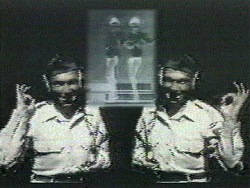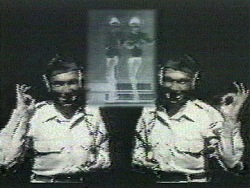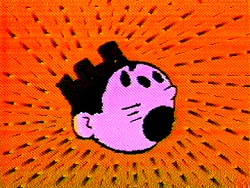Utilizing a two-frame animation technique developed on the Fairlight CVI, Double Trouble is a witty study of motion and gesture as cultural signifiers.
Boldly rendered with rapid proliferations and layers of emblematic, cartoon-like images, Kinema No Yoru is one of a series of works that draw on the iconography of the Japanese children's game "Menko."
Constructed as a dynamic image-world of constant motion, Karkador is a vivid portrayal of the use of media as electronic "hanabi" (fireworks) in Japan.
The Esthetics of Disappearance is derived from a phrase coined by French theorist Paul Virilio, who remarked that the energy of the cinema and, by extension, video derives less from the ephemeral content of each scene than from the edit points or "interruptions."
Description
Produced in Japan, this collection of works is unified by Callas' distinctive formal and thematic strategies, including his intricate electronic layering of iconic images in constant, rapid motion to form vividly patterned and animated landscapes of cultural emblems. Utilizing a two-frame animation technique developed on the Fairlight CVI, Double Trouble is a witty study of motion and gesture as cultural signifiers.
Boldly rendered with rapid proliferations and layers of emblematic, cartoon-like images, Kinema No Yoru is one of a series of works that draw on the iconography of the Japanese children's game "Menko." Callas' Menko Series is based on the idea of the contemporary Japanese use of technology as a form of "territory," a surrogate space actively being "colonized," just as the actual terrain of Asia and the Pacific Territories was colonized during the first half of this century. The accompanying lyrics refer in a pseudo-nostalgic way to the prewar era from which the iconography of the Menko cards derive.
Constructed as a dynamic image-world of constant motion, Karkador is a vivid portrayal of the use of media as electronic "hanabi" (fireworks) in Japan. Writes Callas, "The Japanese media machine is earnestly engaged in the feeding of a vast compressed river of imagery, in which content sinks without a trace like a stone to the bottom." The lyrics of the title song "refer to the experience of random deja-vu, interpreted by the imagery to be nothing other than the experience of watching television."
The Esthetics of Disappearance is derived from a phrase coined by French theorist Paul Virilio, who remarked that the energy of the cinema and, by extension, video derives less from the ephemeral content of each scene than from the edit points or "interruptions." As Callas traces a tangential progression from theatrical space to "speed-space" via cinema and television, the montage accelerates to the point where speed begins to destroy content. Flashes of Japanese cinematic images are overlayed with a profusion of patterns and text inserts, tracing an explosive trajectory of cinema, speed, light and war. 1930s German youth music sung backwards in Japanese, then played forward, is the haunting soundtrack.
Double Trouble: Conceived/Directed/Designed by Peter Callas. Music: RA.
Kinema No Yoru (Film Night): Directed/Designed by Peter Callas. Music: Toshiro Sensui.
Karkador: Conceived/Directed/Designed by Peter Callas. Music: P-Model. Assistance: Alfred Birnbaum.
The Esthetics of Disappearance: Directed/Designed by Peter Callas. Music: Guernica, featuring Jun Togawa. Produced with the assistance of Ringworld, Yoichi Kajima.



